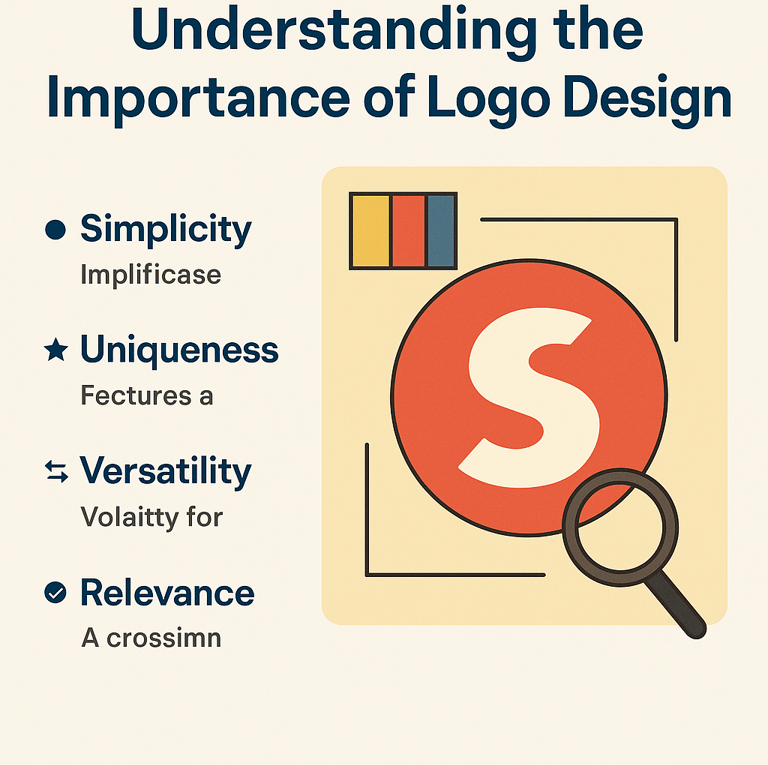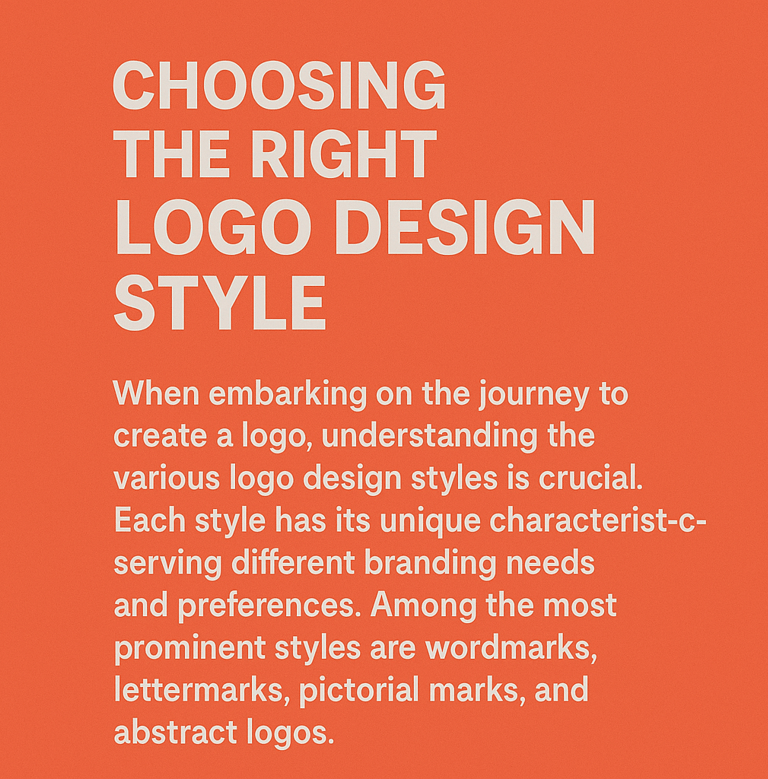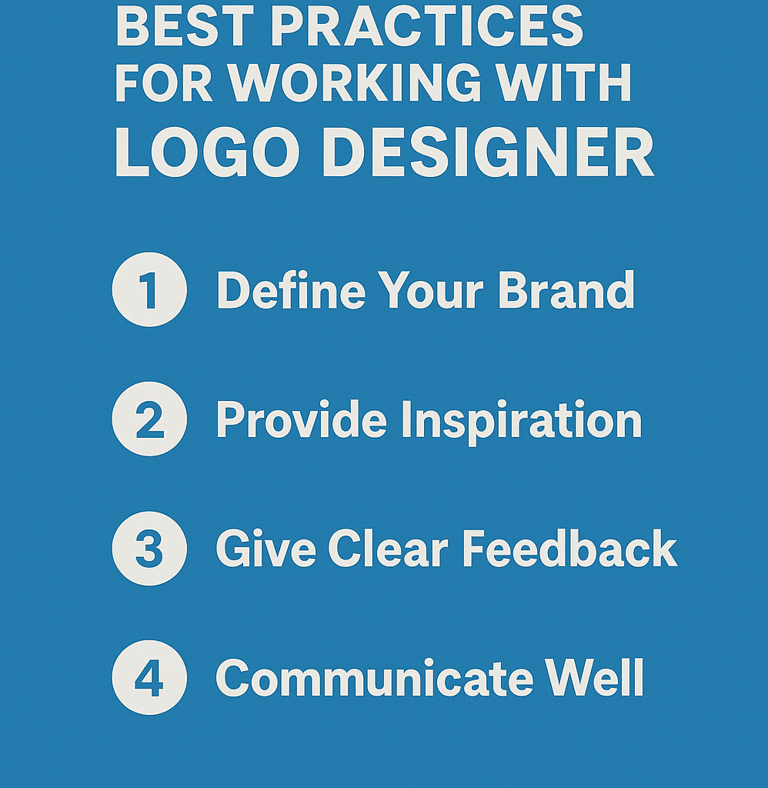"Mastering Logo Design: Build a Unique Brand Identity That Captivates"
"Learn how to master logo design and create a unique brand identity that captivates your audience. This ultimate guide covers essential tips, techniques, and strategies to help you design a logo that leaves a lasting impression."
4/21/20258 min read
Understanding the Importance of Logo Design
Logo design holds a pivotal role in establishing a brand's identity and acts as the face of a company. A well-designed logo conveys a brand's underlying values and serves as a visual representation that encapsulates its mission and vision. It is not merely an aesthetic element but a crucial tool for effective communication with the audience. By integrating core attributes of the brand, a logo creates an immediate connection, fostering an emotional response from potential customers.
One of the primary functions of a logo is to build trust. A professional and cohesive logo design instills a sense of reliability and credibility in consumers. For instance, iconic symbols like the Nike Swoosh or the Apple logo elicit instant recognition and confidence. These logos encapsulate the brand's values and ethos, establishing a trustworthy image that customers can relate to. When consumers identify a brand with such emotional resonance, they are more likely to engage with its products and services.
Furthermore, a memorable logo greatly enhances brand recognition. The simplicity and effectiveness of famous logos, such as those of Coca-Cola or McDonald's, showcase how these brands have secured their place in the minds of consumers. These logos not only differentiate the businesses from their competitors but also foster a sense of loyalty among their customers. The visual imagery connects with the audience, making it easier for them to remember the brand when making purchasing decisions.
In today’s market, where competition is fierce, the importance of effective logo design cannot be understated. A thoughtfully crafted logo significantly contributes to the overarching brand strategy, reflecting its core values, establishing trust, and creating indelible impressions that enhance overall brand recognition.
Key Elements of Effective Logo Design
Creating an effective logo is paramount for establishing a memorable brand identity. Several key elements contribute to the success of a logo, and understanding these aspects can help designers craft an appealing and impactful graphic. Firstly, simplicity is essential. A streamlined logo is easier for audiences to recognize and recall. Complex designs may confuse potential customers, whereas a simple logo allows for quick recognition—vital in a crowded marketplace where brand identities compete for attention.
Uniqueness is another critical aspect. A logo should set a brand apart from its competitors, allowing it to carve its niche in the industry. This uniqueness helps prevent confusion among consumers and discourages any potential legal issues related to trademark infringements. A bespoke logo that embodies the brand's values is more likely to resonate with its target audience.
Versatility is also a necessary consideration in effective logo design. A good logo must perform well across various platforms—whether it appears on a business card, a website, or a large billboard. Logo designs should be scalable and maintain their integrity in different sizes and formats, which is fundamental for a consistent visual identity. Furthermore, a versatile logo can adapt to multiple backgrounds or color schemes, ensuring it remains recognizable and effective in diverse applications.
The relevance of a logo to its corresponding brand cannot be overstated. A logo should reflect the essence, mission, or values of the organization it represents. This connection fosters trust and builds a stronger emotional bond with potential customers, further solidifying the brand identity in their minds. By considering these foundational elements—simplicity, uniqueness, versatility, and relevance—designers can create logos that not only stand out but also embody a strong visual identity crucial for brand recognition and success.
Choosing the Right Logo Design Style
When embarking on the journey to create a logo, understanding the various logo design styles is crucial. Each style has its unique characteristics, serving different branding needs and preferences. Among the most prominent styles are wordmarks, lettermarks, pictorial marks, and abstract logos. Choosing the appropriate style for a brand can greatly influence its identity and market perception.
A wordmark is a logo primarily featuring the company name presented in a distinctive typeface. This style is particularly effective for brands with unique names, as the word becomes the main design element. Companies like Google and Coca- Cola exemplify successful wordmarks, effectively communicating brand identity through typography. This style is often ideal for businesses seeking to establish a strong verbal identity.
Lettermarks, on the other hand, use the initials of the brand, making them ideal for organizations with lengthy names. Famous examples include HBO and CNN, which rely on their abbreviated versions to simplify recognition. This style can be very effective for brands aiming for a minimalist and professional appearance.
Pictorial marks combine images with brand representation, using symbols that encapsulate the essence of the brand. Think of Apple's iconic silhouette or the Twitter bird. These logos communicate brand values and personality visually, allowing for immediate recognition. Pictorial logos often evoke strong emotions and connections with consumers.
Finally, abstract logos leverage shapes and colors to represent a brand conceptually rather than literally. Brands like Nike or Pepsi are great examples of this style, capturing the essence of the brand without relying on a direct image. This approach can foster a unique brand identity that stands out in a competitive market.
In conclusion, identifying the right logo design style is paramount for establishing a compelling brand identity. Each style serves different objectives and resonates differently with audiences, making the selection process a reflection of the brand' s personality. By carefully considering the options, businesses can create a logo that truly stands out.
The Role of Color in Logo Design
Color plays a pivotal role in logo design, acting as a visual language that communicates a brand's message and identity. The psychology of color suggests that colors can evoke specific emotions and associations. For instance, blue often conveys trust and dependability, making it a popular choice for financial institutions. Conversely, red can evoke excitement and energy, frequently used by brands in the food and beverage sector to stimulate appetite.
Different colors evoke various emotional responses, which can significantly influence consumer perception. Yellow is often associated with optimism and friendliness, whereas green is typically linked to health, tranquility, and nature. When designing a logo, understanding the emotional implications of different colors allows businesses to select hues that resonate with their target audience.
A strategic approach to color selection involves defining the brand's core values and target demographic. This process starts with brainstorming potential adjectives that reflect the brand's identity. For example, a tech startup may prefer a sleek, modern palette with cool tones like blue and silver, while a children's brand may opt for vibrant colors to appeal to a younger audience. The key is to ensure that the chosen colors align with the emotions the brand intends to invoke.
Moreover, consistency is vital; utilizing a cohesive color palette across various marketing materials reinforces brand recognition. Brands are often more memorable when they use consistent colors, helping create a unified identity. To assist brands in developing their logo color scheme, creating color combinations that work harmoniously is crucial.
In conclusion, color selection is not only a creative endeavor but a strategic decision that can affect how audiences perceive a brand. By carefully considering the psychology of color, brands can enhance their logo design and foster a stronger connection with their consumers.
Utilizing Fiverr for Professional Logo Design Services
In the contemporary digital landscape, sourcing professional logo design services has become more accessible than ever, with platforms like Fiverr leading the charge. Fiverr serves as a marketplace that connects clients with freelance designers, providing an array of services at varying price points, ensuring that businesses of all sizes can find a solution that fits their budget. For those in need of a distinct brand identity, Fiverr offers a straightforward way to engage with talented designers who can produce unique logos that resonate with target audiences.
One of the primary advantages of utilizing Fiverr for logo design is the affordability factor. Unlike traditional design services that may charge exorbitant fees, Fiverr allows clients to find skilled designers willing to create high-quality logos at competitive prices. This affordability does not compromise the quality of work, as many designers on the platform boast impressive portfolios showcasing their expertise. This ensures that clients can achieve professional-grade designs without stretching their budget excessively.
In addition to cost-effectiveness, Fiverr provides a platform to explore various gigs and packages tailored to specific needs. Customers can browse through numerous designer profiles, assessing each one's experience, style, and past work through customer reviews and ratings. This transparency allows clients to make informed choices based on feedback from previous customers, thus ensuring satisfaction with the final product. Whether one seeks a minimalist logo or something more intricate, Fiverr’s diverse range of offerings caters to all preferences.
In conclusion, for individuals or businesses looking to develop a memorable brand identity, utilizing Fiverr for logo design services is a compelling option that combines affordability with access to talented designers and valuable customer insights. Exploring the gigs available on this platform can lead to the creation of a logo that effectively conveys one's brand message and stands out in a competitive market.
Best Practices for Working with a Logo Designer
Collaborating with a logo designer can be a pivotal step in establishing a strong brand identity. To maximize the effectiveness of this partnership, it is essential to follow best practices that facilitate clear communication and understanding between both parties. To begin with, articulating your vision is crucial. Providing the designer with a detailed outline of your brand's values, target audience, and desired aesthetic is fundamental. This initial briefing should include examples of logos or designs that resonate with you, as visual references can significantly enhance the designer's comprehension of your expectations.
Equally important is the necessity of providing constructive feedback throughout the design process. A designer's ability to refine and evolve the logo depends largely on your input. It is recommended to maintain an open dialogue, expressing not just what you like or dislike, but also the reasons behind your preferences. This nuanced feedback helps the designer grasp your perspective more effectively and fosters a more collaborative atmosphere. Moreover, be prepared to articulate specific elements you would like adjusted, such as colors, typography, or iconography, so that the designer can make informed revisions.
Understanding the design process itself can also alleviate any concerns. Logo creation typically involves several iterations; thus, patience is key. Initial drafts may not meet your expectations, but they often serve as a foundation for refinement. Expect to go through multiple revisions, and embrace this as a necessary part of honing the final product. Additionally, establishing a timeline at the onset of the project can help keep the process on track while allowing for ample time for revisions and finalization. By following these best practices, you can create a productive working relationship with your logo designer, ultimately leading to a distinctive and impactful brand identity.
Conclusion
In conclusion, a well-crafted logo serves as the cornerstone of your brand identity, making it essential for businesses aiming to establish a memorable presence in a competitive market. Throughout this guide, we explored the vital role that logo design plays in encapsulating the essence of your brand. A thoughtfully designed logo not only conveys your brand’s values but also promotes recognition and trust among your target audience. The principles of simplicity, versatility, and relevance discussed in earlier sections highlight what it takes to create a logo that resonates effectively with potential customers.
Choosing the right colors, typography, and imagery can significantly impact how your brand is perceived. As we've seen, these elements can evoke feelings and associations that align with your brand message. Investing time and resources into developing a unique and professional logo will undoubtedly pay dividends in the long run, as it builds credibility and fosters customer loyalty.
As you embark on your branding journey, consider leveraging professional logo design services available on platforms like Fiverr. Whether you are a startup looking to make your mark or an established company seeking a refresh, talented designers are ready to help bring your vision to life. Don’t miss the opportunity to create an unforgettable brand identity that stands out! 🌟💼✨ Start exploring logo design options on Fiverr today and transform your brand into something remarkable.
Ready to create a standout logo?
👉 Explore top designers on Fiverr or try Canva for a quick start.






